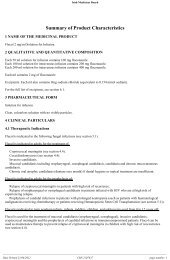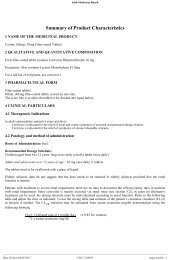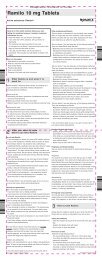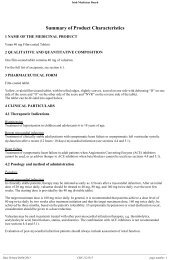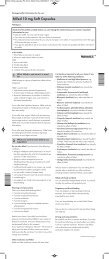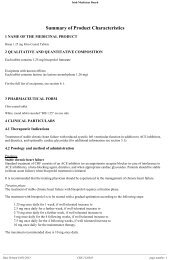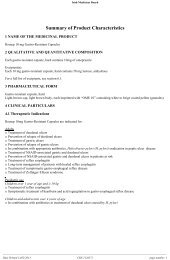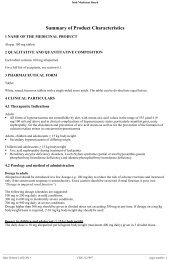Download Vatan 80mg SPC here - Rowex Ltd
Download Vatan 80mg SPC here - Rowex Ltd
Download Vatan 80mg SPC here - Rowex Ltd
You also want an ePaper? Increase the reach of your titles
YUMPU automatically turns print PDFs into web optimized ePapers that Google loves.
Irish Medicines Board<br />
1 NAME OF THE MEDICINAL PRODUCT<br />
<strong>Vatan</strong> 80 mg Film-coated Tablets<br />
Summary of Product Characteristics<br />
2 QUALITATIVE AND QUANTITATIVE COMPOSITION<br />
One film-coated tablet contains 80 mg of valsartan<br />
For the full list of excipients, see section 6.1.<br />
3 PHARMACEUTICAL FORM<br />
Film-coated tablet<br />
Pale-red, round film-coated tablet with bevelled edges, scored on one side with debossing “D” on one side of the score<br />
and “V” on the other side of the score and “NVR” on the reverse side of the tablet.<br />
The score line is only to facilitate breaking for ease of swallowing and not to divide into equal doses.<br />
4 CLINICAL PARTICULARS<br />
4.1 Therapeutic Indications<br />
Hypertension<br />
Treatment of essential hypertension in adults, and hypertension in children and adolescents 6 to 18 years of age.<br />
Recent myocardial infarction<br />
Treatment of clinically stable adult patients with symptomatic heart failure or asymptomatic left ventricular systolic<br />
dysfunction after a recent (12 hours-10 days) myocardial infarction (see sections 4.4 and 5.1).<br />
Heart failure<br />
Treatment of symptomatic heart failure in adult patients when Angiotensin Converting Enzyme (ACE) inhibitors<br />
cannot be used, or as add-on therapy to ACE inhibitors when beta blockers cannot be used (see sections 4.4 and 5.1).<br />
4.2 Posology and method of administration<br />
Posology<br />
Hypertension<br />
The recommended starting dose of <strong>Vatan</strong> is 80 mg once daily. The antihypertensive effect is substantially present<br />
within 2 weeks, and maximal effects are attained within 4 weeks. In some patients whose blood pressure is not<br />
adequately controlled, the dose can be increased to 160 mg and to a maximum of 320 mg.<br />
<strong>Vatan</strong> may also be administered with other antihypertensive agents. The addition of a diuretic such as<br />
hydrochlorothiazide will decrease blood pressure even further in these patients.<br />
Recent myocardial infarction<br />
In clinically stable patients, therapy may be initiated as early as 12 hours after a myocardial infarction. After an initial<br />
dose of 20 mg twice daily, valsartan should be titrated to 40 mg, 80 mg, and 160 mg twice daily over the next few<br />
weeks. The starting dose is provided by the 40 mg divisible tablet.<br />
The target maximum dose is 160 mg twice daily. In general, it is recommended that patients achieve a dose level of<br />
80 mg twice daily by two weeks after treatment initiation and that the target maximum dose, 160 mg twice daily, be<br />
achieved by three months, based on the patient's tolerability.<br />
______________________________________________________________________________________________________________________<br />
Date Printed 08/10/2013 CRN 2138217 page number: 1
Irish Medicines Board<br />
If symptomatic hypotension or renal dysfunction occur, consideration should be given to a dose reduction.<br />
Valsartan may be used in patients treated with other post-myocardial infarction therapies, e.g. thrombolytics,<br />
acetylsalicylic acid, beta blockers, statins, and diuretics. The combination with ACE inhibitors is not recommended<br />
(see sections 4.4 and 5.1).<br />
Evaluation of post-myocardial infarction patients should always include assessment of renal function.<br />
Heart failure<br />
The recommended starting dose of <strong>Vatan</strong> is 40 mg twice daily. Uptitration to 80 mg and 160 mg twice daily should be<br />
done at intervals of at least two weeks to the highest dose, as tolerated by the patient. Consideration should be given to<br />
reducing the dose of concomitant diuretics. The maximum daily dose administered in clinical trials is 320 mg in<br />
divided doses.<br />
Valsartan may be administered with other heart failure therapies. However, the triple combination of an ACE inhibitor,<br />
a beta blocker and valsartan is not recommended (see sections 4.4 and 5.1).<br />
Evaluation of patients with heart failure should always include assessment of renal function.<br />
Additional information on special populations<br />
Elderly<br />
No dose adjustment is required in elderly patients.<br />
Renal impairment<br />
No dose adjustment is required for adult patients with a creatinine clearance >10 ml/min (see sections 4.4 and 5.2).<br />
Hepatic impairment<br />
<strong>Vatan</strong> is contraindicated in patients with severe hepatic impairment, biliary cirrhosis and in patients with cholestasis<br />
(see sections 4.3, 4.4 and 5.2). In patients with mild to moderate hepatic impairment without cholestasis, the dose of<br />
valsartan should not exceed 80 mg.<br />
Paediatric population<br />
Paediatric hypertension<br />
Children and adolescents 6 to 18 years of age<br />
The initial dose is 40 mg once daily for children weighing below 35 kg and 80 mg once daily for those weighing 35 kg<br />
or more. The dose should be adjusted based on blood pressure response. For maximum doses studied in clinical trials<br />
please refer to the table below.<br />
Doses higher than those listed have not been studied and are t<strong>here</strong>fore not recommended.<br />
Weight<br />
≥18 kg to
Irish Medicines Board<br />
Use in paediatric patients aged 6 to 18 years with hepatic impairment<br />
As in adults, <strong>Vatan</strong> is contraindicated in paediatric patients with severe hepatic impairment, biliary cirrhosis and in<br />
patients with cholestasis (see sections 4.3, 4.4 and 5.2). T<strong>here</strong> is limited clinical experience with Valsartan in paediatric<br />
patients with mild to moderate hepatic impairment. The dose of valsartan should not exceed 80 mg in these patients.<br />
Paediatric heart failure and recent myocardial infarction<br />
<strong>Vatan</strong> is not recommended for the treatment of heart failure or recent myocardial infarction in children and adolescents<br />
below the age of 18 years due to the lack of data on safety and efficacy.<br />
Method of administration<br />
<strong>Vatan</strong> may be taken independently of a meal and should be administered with water.<br />
4.3 Contraindications<br />
- Hypersensitivity to the active substance or to any of the excipients listed in section 6.1.<br />
- Severe hepatic impairment, biliary cirrhosis and cholestasis.<br />
- Second and third trimester of pregnancy (see sections 4.4 and 4.6).<br />
4.4 Special warnings and precautions for use<br />
Hyperkalaemia<br />
Concomitant use with potassium supplements, potassium-sparing diuretics, salt substitutes containing potassium, or<br />
other agents that may increase potassium levels (heparin, etc.) is not recommended. Monitoring of potassium should be<br />
undertaken as appropriate.<br />
Impaired renal function<br />
T<strong>here</strong> is currently no experience on the safe use in patients with a creatinine clearance 10 ml/min (see sections 4.2 and 5.2).<br />
Hepatic impairment<br />
In patients with mild to moderate hepatic impairment without cholestasis, valsartan should be used with caution (see<br />
sections 4.2 and 5.2).<br />
Sodium- and/or volume-depleted patients<br />
In severely sodium-depleted and/or volume-depleted patients, such as those receiving high doses of diuretics,<br />
symptomatic hypotension may occur in rare cases after initiation of therapy with valsartan. Sodium and/or volume<br />
depletion should be corrected before starting treatment with <strong>Vatan</strong>, for example by reducing the diuretic dose.<br />
Renal artery stenosis<br />
In patients with bilateral renal artery stenosis or stenosis to a solitary kidney, the safe use of <strong>Vatan</strong> has not been<br />
established.<br />
Short-term administration of valsartan to twelve patients with renovascular hypertension secondary to unilateral renal<br />
artery stenosis did not induce any significant changes in renal haemodynamics, serum creatinine, or blood urea nitrogen<br />
(BUN). However, other agents that affect the renin-angiotensin system may increase blood urea and serum creatinine in<br />
patients with unilateral renal artery stenosis, t<strong>here</strong>fore monitoring of renal function is recommended when patients are<br />
treated with valsartan.<br />
Kidney transplantation<br />
T<strong>here</strong> is currently no experience on the safe use of valsartan in patients who have recently undergone kidney<br />
transplantation.<br />
______________________________________________________________________________________________________________________<br />
Date Printed 08/10/2013 CRN 2138217 page number: 3
Irish Medicines Board<br />
Primary hyperaldosteronism<br />
Patients with primary hyperaldosteronism should not be treated with valsartan as their renin-angiotensin system is not<br />
activated.<br />
Aortic and mitral valve stenosis, obstructive hypertrophic cardiomyopathy<br />
As with all other vasodilators, special caution is indicated in patients suffering from aortic or mitral stenosis, or<br />
hypertrophic obstructive cardiomyopathy (HOCM).<br />
Pregnancy<br />
Angiotensin II Receptor Antagonists (AIIRAs) should not be initiated during pregnancy. Unless continued AIIRAs<br />
therapy is considered essential, patients planning pregnancy should be changed to alternative anti-hypertensive<br />
treatments which have an established safety profile for use in pregnancy. When pregnancy is diagnosed, treatment with<br />
AIIRAs should be stopped immediately, and, if appropriate, alternative therapy should be started (see sections 4.3 and<br />
4.6).<br />
Recent myocardial infarction<br />
The combination of captopril and valsartan has shown no additional clinical benefit, instead the risk for adverse events<br />
increased compared to treatment with the respective therapies (see sections 4.2 and 5.1). T<strong>here</strong>fore, the combination of<br />
valsartan with an ACE inhibitor is not recommended.<br />
Caution should be observed when initiating therapy in post-myocardial infarction patients. Evaluation of postmyocardial<br />
infarction patients should always include assessment of renal function (see section 4.2).<br />
Use of valsartan in post-myocardial infarction patients commonly results in some reduction in blood pressure, but<br />
discontinuation of therapy because of continuing symptomatic hypotension is not usually necessary provided dosing<br />
instructions are followed (see section 4.2).<br />
Heart Failure<br />
In patients with heart failure, the triple combination of an ACE inhibitor, a beta blocker and valsartan has not shown<br />
any clinical benefit (see section 5.1). This combination apparently increases the risk for adverse events and is t<strong>here</strong>fore<br />
not recommended.<br />
Caution should be observed when initiating therapy in patients with heart failure. Evaluation of patients with heart<br />
failure should always include assessment of renal function (see section 4.2).<br />
Use of valsartan in patients with heart failure commonly results in some reduction in blood pressure, but<br />
discontinuation of therapy because of continuing symptomatic hypotension is not usually necessary provided dosing<br />
instructions are followed (see section 4.2).<br />
In patients whose renal function may depend on the activity of the renin-angiotensin system (e.g patients with severe<br />
congestive heart failure), treatment with angiotensin converting enzyme inhibitors has been associated with oliguria<br />
and/or progressive azotaemia and in rare cases with acute renal failure and/or death. As valsartan is an angiotensin II<br />
antagonist, it cannot be excluded that the use of <strong>Vatan</strong> may be associated with impairment of the renal function.<br />
History of angioedema<br />
Angioedema, including swelling of the larynx and glottis, causing airway obstruction and/or swelling of the face, lips,<br />
pharynx, and/or tongue has been reported in patients treated with valsartan; some of these patients previously<br />
experienced angioedema with other drugs including ACE inhibitors. <strong>Vatan</strong> should be immediately discontinued in<br />
patients who develop angioedema, and valsartan should not be re-administered (see section 4.8).<br />
Paediatric population<br />
Impaired renal function<br />
Use in paediatric patients with a creatinine clearance 30 ml/min (see sections 4.2 and 5.2). Renal function and serum potassium should<br />
______________________________________________________________________________________________________________________<br />
Date Printed 08/10/2013 CRN 2138217 page number: 4
Irish Medicines Board<br />
be closely monitored during treatment with valsartan. This applies particularly when valsartan is given in the presence<br />
of other conditions (fever, dehydration) likely to impair renal function.<br />
Impaired hepatic function<br />
As in adults, <strong>Vatan</strong> is contraindicated in paediatric patients with severe hepatic impairment, biliary cirrhosis and in<br />
patients with cholestasis (see sections 4.3 and 5.2). T<strong>here</strong> is limited clinical experience with valsartan in paediatric<br />
patients with mild to moderate hepatic impairment. The dose of valsartan should not exceed 80 mg in these patients.<br />
4.5 Interaction with other medicinal products and other forms of interaction<br />
Concomitant use not recommended<br />
Lithium<br />
Reversible increases in serum lithium concentrations and toxicity have been reported during concurrent use of ACE<br />
inhibitors. Due to the lack of experience with concomitant use of valsartan and lithium, this combination is not<br />
recommended. If the combination proves necessary, careful monitoring of serum lithium levels is recommended.<br />
Potassium-sparing diuretics, potassium supplements, salt substitutes containing potassium and other substances that<br />
may increase potassium levels<br />
If a medicinal product that affects potassium levels is considered necessary in combination with valsartan, monitoring<br />
of potassium plasma levels is advised.<br />
Caution required with concomitant use<br />
Non-steroidal anti-inflammatory medicines (NSAIDs), including selective COX - 2 inhibitors, acetylsalicylic acid<br />
>3 g/day), and non-selective NSAIDs<br />
When angiotensin II antagonists are administered simultaneously with NSAIDs, attenuation of the antihypertensive<br />
effect may occur. Furthermore, concomitant use of angiotensin II antagonists and NSAIDs may lead to an increased<br />
risk of worsening of renal function and an increase in serum potassium. T<strong>here</strong>fore, monitoring of renal function at the<br />
beginning of the treatment is recommended, as well as adequate hydration of the patient.<br />
Transporters<br />
In vitro data indicates that valsartan is a substrate of the hepatic uptake transporter OATP1B1/OATP1B3 and the<br />
hepatic efflux transporter MRP2. The clinical relevance of this finding is unknown. Co-administration of inhibitors of<br />
the uptake transporter (rifampin, ciclosporin) or efflux transporter (ritonavir) may increase the systemic exposure to<br />
valsartan. Exercise appropriate care when initiating or ending concomitant treatment with such drugs.<br />
Others<br />
In drug interaction studies with valsartan, no interactions of clinical significance have been found with valsartan or any<br />
of the following substances: cimetidine, warfarin, furosemide, digoxin, atenolol, indometacin, hydrochlorothiazide,<br />
amlodipine, glibenclamide.<br />
Paediatric population<br />
In hypertension in children and adolescents, w<strong>here</strong> underlying renal abnormalities are common, caution is<br />
recommended with the concomitant use of valsartan and other substances that inhibit the renin angiotensin aldosterone<br />
system which may increase serum potassium. Renal function and serum potassium should be closely monitored.<br />
______________________________________________________________________________________________________________________<br />
Date Printed 08/10/2013 CRN 2138217 page number: 5
Irish Medicines Board<br />
4.6 Fertility, pregnancy and lactation<br />
Pregnancy<br />
The use of Angiotensin II Receptor Antagonists (AIIRAs) is not recommended during the first trimester of pregnancy<br />
(see section 4.4). The use of AIIRAs is contra-indicated during the second and third trimester of pregnancy (see<br />
sections 4.3 and 4.4).<br />
Epidemiological evidence regarding the risk of teratogenicity following exposure to ACE inhibitors during the first<br />
trimester of pregnancy has not been conclusive; however, a small increase in risk cannot be excluded. Whilst t<strong>here</strong> is<br />
no controlled epidemiological data on the risk with AIIRAs, similar risks may exist for this class of drugs. Unless<br />
continued AIIRA therapy is considered essential, patients planning pregnancy should be changed to alternative antihypertensive<br />
treatments which have an established safety profile for use in pregnancy. When pregnancy is diagnosed,<br />
treatment with AIIRAs should be stopped immediately, and, if appropriate, alternative therapy should be started.<br />
AIIRAs therapy exposure during the second and third trimesters is known to induce human fetotoxicity (decreased<br />
renal function, oligohydramnios, skull ossification retardation) and neonatal toxicity (renal failure, hypotension,<br />
hyperkalaemia); see also section 5.3 “Preclinical safety data”.<br />
Should exposure to AIIRAs have occurred from the second trimester of pregnancy, ultrasound check of renal function<br />
and skull is recommended.<br />
Infants whose mothers have taken AIIRAs should be closely observed for hypotension (see also sections 4.3 and 4.4).<br />
Breast-feeding<br />
Because no information is available regarding the use of valsartan during breastfeeding, <strong>Vatan</strong> is not recommended and<br />
alternative treatments with better established safety profiles during breast-feeding are preferable, especially while<br />
nursing a newborn or preterm infant.<br />
Fertility<br />
Valsartan had no adverse effects on the reproductive performance of male or female rats at oral doses up to<br />
200 mg/kg/day. This dose is 6 times the maximum recommended human dose on a mg/m 2 basis (calculations assume<br />
an oral dose of 320 mg/day and a 60-kg patient).<br />
4.7 Effects on ability to drive and use machines<br />
No studies on the effects on the ability to drive have been performed. When driving vehicles or operating machines it<br />
should be taken into account that occasionally dizziness or weariness may occur.<br />
4.8 Undesirable effects<br />
In controlled clinical studies in adult patients with hypertension, the overall incidence of adverse reactions (ADRs) was<br />
comparable with placebo and is consistent with the pharmacology of valsartan. The incidence of ADRs did not appear<br />
to be related to dose or treatment duration and also showed no association with gender, age or race.<br />
The ADRs reported from clinical studies, post-marketing experience and laboratory findings are listed below according<br />
to system organ class.<br />
Adverse reactions are ranked by frequency, the most frequent first, using the following convention: very common<br />
(≥1/10); common (≥1/100 to
Irish Medicines Board<br />
For all the ADRs reported from post-marketing experience and laboratory findings, it is not possible to apply any ADR<br />
frequency and t<strong>here</strong>fore they are mentioned with a "not known" frequency.<br />
- Hypertension<br />
Blood and lymphatic system disorders<br />
Not known<br />
Paediatric population<br />
Hypertension<br />
Decrease in haemoglobin, Decrease in<br />
haematocrit, Neutropenia, Thrombocytopenia<br />
Immune system disorders<br />
Not known<br />
Hypersensitivity including serum sickness<br />
Metabolism and nutrition disorders<br />
Not known<br />
Increase of serum potassium, hyponatraemia<br />
Ear and labyrinth system disorders<br />
Uncommon<br />
Vertigo<br />
Vascular disorders<br />
Not known<br />
Vasculitis<br />
Respiratory, thoracic and mediastinal disorders<br />
Uncommon<br />
Cough<br />
Gastrointestinal disorders<br />
Uncommon<br />
Abdominal pain<br />
Hepato-biliary disorders<br />
Not known<br />
Elevation of liver function values including<br />
increase of serum bilirubin<br />
Skin and subcutaneous tissue disorders<br />
Not known<br />
Angioedema, Rash, Pruritus<br />
Musculoskeletal and connective tissue disorders<br />
Not known<br />
Myalgia<br />
Renal and urinary disorders<br />
Not known<br />
General disorders and administration site conditions<br />
Uncommon<br />
Fatigue<br />
Renal failure and impairment, Elevation of<br />
serum creatinine<br />
The antihypertensive effect of valsartan has been evaluated in two randomised, double-blind clinical studies in<br />
561 paediatric patients from 6 to 18 years of age. With the exception of isolated gastrointestinal disorders (like<br />
abdominal pain, nausea, vomiting) and dizziness, no relevant differences in terms of type, frequency and severity of<br />
adverse reactions were identified between the safety profile for paediatric patients aged 6 to 18 years and that<br />
previously reported for adult patients.<br />
Neurocognitive and developmental assessment of paediatric patients aged 6 to 16 years of age revealed no overall<br />
clinically relevant adverse impact after treatment with valsartan for up to one year.<br />
In a double-blind randomized study in 90 children aged 1 to 6 years, which was followed by a one-year open-label<br />
extension, two deaths and isolated cases of marked liver transaminases elevations were observed. These cases occurred<br />
in a population who had significant comorbidities. A causal relationship to valsartan has not been established. In a<br />
second study in which 75 children aged 1 to 6 years were randomised, no significant liver transaminase elevations or<br />
death occurred with valsartan treatment.<br />
Hyperkalaemia was more frequently observed in children and adolescents aged 6 to 18 years with underlying chronic<br />
kidney disease.<br />
______________________________________________________________________________________________________________________<br />
Date Printed 08/10/2013 CRN 2138217 page number: 7
Irish Medicines Board<br />
The safety profile seen in controlled-clinical studies in adult patients with post-myocardial infarction and/or heart<br />
failure varies from the overall safety profile seen in hypertensive patients. This may relate to the patients underlying<br />
disease. ADRs that occurred in adult patients with post-myocardial infarction and/or heart failure patients are listed<br />
below.<br />
- Post-myocardial infarction and/or heart failure (studied in adult patients only)<br />
Blood and lymphatic system disorders<br />
Not known<br />
Thrombocytopenia<br />
Immune system disorders<br />
Not known<br />
Hypersensitivity including serum sickness<br />
Metabolism and nutrition disorders<br />
Uncommon<br />
Hyperkalaemia<br />
Not known<br />
Increase of serum potassium, hyponatraemia<br />
Nervous system disorders<br />
Common<br />
Dizziness, Postural dizziness<br />
Uncommon<br />
Syncope, Headache<br />
Ear and labyrinth system disorders<br />
Uncommon<br />
Vertigo<br />
Cardiac disorders<br />
Uncommon<br />
Cardiac failure<br />
Vascular disorders<br />
Common<br />
Hypotension, Orthostatic hypotension<br />
Not known<br />
Vasculitis<br />
Respiratory, thoracic and mediastinal disorders<br />
Uncommon<br />
Cough<br />
Gastrointestinal disorders<br />
Uncommon<br />
Nausea, Diarrhoea<br />
Hepato-biliary disorders<br />
Not known<br />
Elevation of liver function values<br />
Skin and subcutaneous tissue disorders<br />
Uncommon<br />
Angioedema<br />
Not known<br />
Rash, Pruritus<br />
Musculoskeletal and connective tissue disorders<br />
Not known<br />
Myalgia<br />
Renal and urinary disorders<br />
Common<br />
Renal failure and impairment<br />
Uncommon<br />
Acute renal failure, Elevation of serum<br />
creatinine<br />
Not known<br />
Increase in Blood Urea Nitrogen<br />
General disorders and administration site conditions<br />
Uncommon<br />
Asthenia, Fatigue<br />
4.9 Overdose<br />
Symptoms<br />
Overdose with valsartan may result in marked hypotension, which could lead to depressed level of consciousness,<br />
circulatory collapse and/or shock.<br />
Treatment<br />
The therapeutic measures depend on the time of ingestion and the type and severity of the symptoms; stabilisation of<br />
the circulatory condition is of prime importance.<br />
______________________________________________________________________________________________________________________<br />
Date Printed 08/10/2013 CRN 2138217 page number: 8
Irish Medicines Board<br />
If hypotension occurs, the patient should be placed in a supine position and blood volume correction should be<br />
undertaken.<br />
Valsartan is unlikely to be removed by haemodialysis.<br />
5 PHARMACOLOGICAL PROPERTIES<br />
5.1 Pharmacodynamic properties<br />
Pharmacotherapeutic group: Angiotensin II Antagonists, plain, ATC code: C09CA03<br />
Valsartan is an orally active, potent, and specific angiotensin II (Ang II) receptor antagonist. It acts selectively on the<br />
AT 1<br />
receptor subtype, which is responsible for the known actions of angiotensin II. The increased plasma levels of Ang<br />
II following AT 1<br />
receptor blockade with valsartan may stimulate the unblocked AT 2<br />
receptor, which appears to<br />
counterbalance the effect of the AT 1<br />
receptor. Valsartan does not exhibit any partial agonist activity at the AT 1<br />
receptor<br />
and has much (about 20,000 fold) greater affinity for the AT 1<br />
receptor than for the AT 2<br />
receptor. Valsartan is not<br />
known to bind to or block other hormone receptors or ion channels known to be important in cardiovascular regulation.<br />
Valsartan does not inhibit ACE (also known as kininase II) which converts Ang I to Ang II and degrades bradykinin.<br />
Since t<strong>here</strong> is no effect on ACE and no potentiation of bradykinin or substance P, angiotensin II antagonists are<br />
unlikely to be associated with coughing. In clinical trials w<strong>here</strong> valsartan was compared with an ACE inhibitor, the<br />
incidence of dry cough was significantly (p
Irish Medicines Board<br />
At 30 weeks, the percentage change in UAE was significantly reduced by 36% from baseline with valsartan 160 mg<br />
(95%CI: 22 to 47%), and by 44% with valsartan 320 mg (95%CI: 31 to 54%). It was concluded that 160-320 mg of<br />
valsartan produced clinically relevant reductions in UAE in hypertensive patients with type 2 diabetes.<br />
Recent myocardial infarction<br />
The VALsartan In Acute myocardial iNfarcTion trial (VALIANT) was a randomised, controlled, multinational, doubleblind<br />
study in 14,703 patients with acute myocardial infarction and signs, symptoms or radiological evidence of<br />
congestive heart failure and/or evidence of left ventricular systolic dysfunction (manifested as an ejection fraction<br />
≤40% by radionuclide ventriculography or ≤35% by echocardiography or ventricular contrast angiography). Patients<br />
were randomised within 12 hours to 10 days after the onset of myocardial infarction symptoms to valsartan, captopril,<br />
or the combination of both. The mean treatment duration was two years. The primary endpoint was time to all-cause<br />
mortality.<br />
Valsartan was as effective as captopril in reducing all-cause mortality after myocardial infarction. All-cause mortality<br />
was similar in the valsartan (19.9%), captopril (19.5%), and valsartan + captopril (19.3%) groups. Combining valsartan<br />
with captopril did not add further benefit over captopril alone. T<strong>here</strong> was no difference between valsartan and captopril<br />
in all-cause mortality based on age, gender, race, baseline therapies or underlying disease. Valsartan was also effective<br />
in prolonging the time to and reducing cardiovascular mortality, hospitalisation for heart failure, recurrent myocardial<br />
infarction, resuscitated cardiac arrest, and non-fatal stroke (secondary composite endpoint).<br />
The safety profile of valsartan was consistent with the clinical course of patients treated in the post-myocardial<br />
infarction setting. Regarding renal function, doubling of serum creatinine was observed in 4.2% of valsartan-treated<br />
patients, 4.8% of valsartan+captopril-treated patients, and 3.4% of captopril-treated patients. Discontinuations due to<br />
various types of renal dysfunction occurred in 1.1% of valsartan-treated patients, 1.3% in valsartan+captopril patients,<br />
and 0.8% of captopril patients. An assessment of renal function should be included in the evaluation of patients postmyocardial<br />
infarction.<br />
T<strong>here</strong> was no difference in all-cause mortality, cardiovascular mortality or morbidity when beta blockers were<br />
administered together with the combination of valsartan + captopril, valsartan alone, or captopril alone. Irrespective of<br />
treatment, mortality was lower in the group of patients treated with a beta blocker, suggesting that the known beta<br />
blocker benefit in this population was maintained in this trial.<br />
Heart failure<br />
Val-HeFT was a randomised, controlled, multinational clinical trial of valsartan compared with placebo on morbidity<br />
and mortality in 5,010 NYHA class II (62%), III (36%) and IV (2%) heart failure patients receiving usual therapy with<br />
LVEF 2.9 cm/m 2 . Baseline therapy included ACE<br />
inhibitors (93%), diuretics (86%), digoxin (67%) and beta blockers (36%). The mean duration of follow-up was nearly<br />
two years. The mean daily dose of valsartan in Val-HeFT was 254 mg. The study had two primary endpoints: all cause<br />
mortality (time to death) and composite mortality and heart failure morbidity (time to first morbid event) defined as<br />
death, sudden death with resuscitation, hospitalisation for heart failure, or administration of intravenous inotropic or<br />
vasodilator agents for four hours or more without hospitalisation.<br />
All cause mortality was similar (p=NS) in the valsartan (19.7%) and placebo (19.4%) groups. The primary benefit was<br />
a 27.5% (95% CI: 17 to 37%) reduction in risk for time to first heart failure hospitalisation (13.9% vs. 18.5%). Results<br />
appearing to favour placebo (composite mortality and morbidity was 21.9% in placebo vs. 25.4% in valsartan group)<br />
were observed for those patients receiving the triple combination of an ACE inhibitor, a beta blocker and valsartan.<br />
In a subgroup of patients not receiving an ACE inhibitor (n=366), the morbidity benefits were greatest. In this subgroup<br />
all-cause mortality was significantly reduced with valsartan compared to placebo by 33% (95% CI: –6% to 58%)<br />
(17.3% valsartan vs. 27.1% placebo) and the composite mortality and morbidity risk was significantly reduced by 44%<br />
(24.9% valsartan vs. 42.5% placebo).<br />
In patients receiving an ACE inhibitor without a beta-blocker, all cause mortality was similar (p=NS) in the valsartan<br />
(21.8%) and placebo (22.5%) groups. Composite mortality and morbidity risk was significantly reduced by 18.3%<br />
(95% CI: 8% to 28%) with valsartan compared with placebo (31.0% vs. 36.3%).<br />
______________________________________________________________________________________________________________________<br />
Date Printed 08/10/2013 CRN 2138217 page number: 10
Irish Medicines Board<br />
In the overall Val-HeFT population, valsartan treated patients showed significant improvement in NYHA class, and<br />
heart failure signs and symptoms, including dyspnoea, fatigue, oedema and rales compared to placebo. Patients treated<br />
with valsartan had a better quality of life as demonstrated by change in the Minnesota Living with Heart Failure<br />
Quality of Life score from baseline at endpoint than placebo. Ejection fraction in valsartan treated patients was<br />
significantly increased and LVIDD significantly reduced from baseline at endpoint compared to placebo.<br />
Paediatric population<br />
Hypertension<br />
The antihypertensive effect of valsartan have been evaluated in four randomized, double-blind clinical studies in<br />
561 paediatric patients from 6 to 18 years of age and 165 paediatric patients 1 to 6 years of age. Renal and urinary<br />
disorders, and obesity were the most common underlying medical conditions potentially contributing to hypertension in<br />
the children enrolled in these studies.<br />
Clinical experience in children at or above 6 years of age<br />
In a clinical study involving 261 hypertensive paediatric patients 6 to 16 years of age, patients who weighed
Irish Medicines Board<br />
Distribution:<br />
The steady-state volume of distribution of valsartan after intravenous administration is about 17 litres, indicating that<br />
valsartan does not distribute into tissues extensively. Valsartan is highly bound to serum proteins (94–97%), mainly<br />
serum albumin.<br />
Biotransformation:<br />
Valsartan is not biotransformed to a high extent as only about 20% of dose is recovered as metabolites. A hydroxy<br />
metabolite has been identified in plasma at low concentrations (less than 10% of the valsartan AUC). This metabolite is<br />
pharmacologically inactive.<br />
Elimination:<br />
Valsartan shows multiexponential decay kinetics (t ½α<br />
10 ml/min). T<strong>here</strong> is currently no experience on the safe use in patients<br />
with a creatinine clearance
Irish Medicines Board<br />
5.3 Preclinical safety data<br />
Non-clinical data reveal no special hazard for humans based on conventional studies of safety pharmacology, repeated<br />
dose toxicity, genotoxicity, carcinogenic potential.<br />
In rats, maternally toxic doses (600 mg/kg/day) during the last days of gestation and lactation led to lower survival,<br />
lower weight gain and delayed development (pinna detachment and ear-canal opening) in the offspring (see section<br />
4.6). These doses in rats (600 mg/kg/day) are approximately 18 times the maximum recommended human dose on a<br />
mg/m 2 basis (calculations assume an oral dose of 320 mg/day and a 60-kg patient).<br />
In non-clinical safety studies, high doses of valsartan (200 to 600 mg/kg body weight) caused in rats a reduction of red<br />
blood cell parameters (erythrocytes, haemoglobin, haematocrit) and evidence of changes in renal haemodynamics<br />
(slightly raised plasma urea, and renal tubular hyperplasia and basophilia in males). These doses in rats (200 and<br />
600 mg/kg/day) are approximately 6 and 18 times the maximum recommended human dose on a mg/m 2 basis<br />
(calculations assume an oral dose of 320 mg/day and a 60-kg patient).<br />
In marmosets at similar doses, the changes were similar though more severe, particularly in the kidney w<strong>here</strong> the<br />
changes developed to a nephropathy which included raised urea and creatinine.<br />
Hypertrophy of the renal juxtaglomerular cells was also seen in both species. All changes were considered to be caused<br />
by the pharmacological action of valsartan which produces prolonged hypotension, particularly in marmosets. For<br />
therapeutic doses of valsartan in humans, the hypertrophy of the renal juxtaglomerular cells does not seem to have any<br />
relevance.<br />
Paediatric population<br />
Daily oral dosing of neonatal/juvenile rats (from a postnatal day 7 to postnatal day 70) with valsartan at doses as low as<br />
1 mg/kg/day (about 10-35% of the maximum recommended paediatric dose of 4 mg/kg/day on systemic exposure<br />
basis) produced persistent, irreversible kidney damage. These effects above mentioned represent an expected<br />
exaggerated pharmacological effect of angiotensin converting enzyme inhibitors and angiotensin II type 1 blockers;<br />
such effects are observed if rats are treated during the first 13 days of life. This period coincides with 36 weeks of<br />
gestation in humans, which could occasionally extend up to 44 weeks after conception in humans. The rats in the<br />
juvenile valsartan study were dosed up to day 70, and effects on renal maturation (postnatal 4-6 weeks) cannot be<br />
excluded. Functional renal maturation is an ongoing process within the first year of life in humans. Consequently, a<br />
clinical relevance in children
Irish Medicines Board<br />
6.2 Incompatibilities<br />
Not applicable<br />
6.3 Shelf life<br />
3 years<br />
6.4 Special precautions for storage<br />
Do not store above 30°C.<br />
Store in the original package in order to protect from moisture.<br />
6.5 Nature and contents of container<br />
PVC/PVDC blister packs<br />
PVC/PE/PVDC blister packs<br />
PA/AL/PVC blister packs<br />
All blister packs are backed with an aluminium foil with heat seal lacquer (Vinyl/Acryl).<br />
Pack sizes: one pack containing 7, 10, 14, 15, 20, 28, 30, 50, 50x1, 56, 60, 84, 90, 98, 100 or 280 film-coated tablets.<br />
Not all pack sizes may be marketed.<br />
6.6 Special precautions for disposal<br />
No special requirements<br />
7 MARKETING AUTHORISATION HOLDER<br />
<strong>Rowex</strong> <strong>Ltd</strong><br />
Bantry<br />
Co Cork<br />
Ireland<br />
8 MARKETING AUTHORISATION NUMBER<br />
PA 711/183/2<br />
9 DATE OF FIRST AUTHORISATION/RENEWAL OF THE AUTHORISATION<br />
Date of first authorisation: 24 September 2010<br />
10 DATE OF REVISION OF THE TEXT<br />
September 2013<br />
______________________________________________________________________________________________________________________<br />
Date Printed 08/10/2013 CRN 2138217 page number: 14



